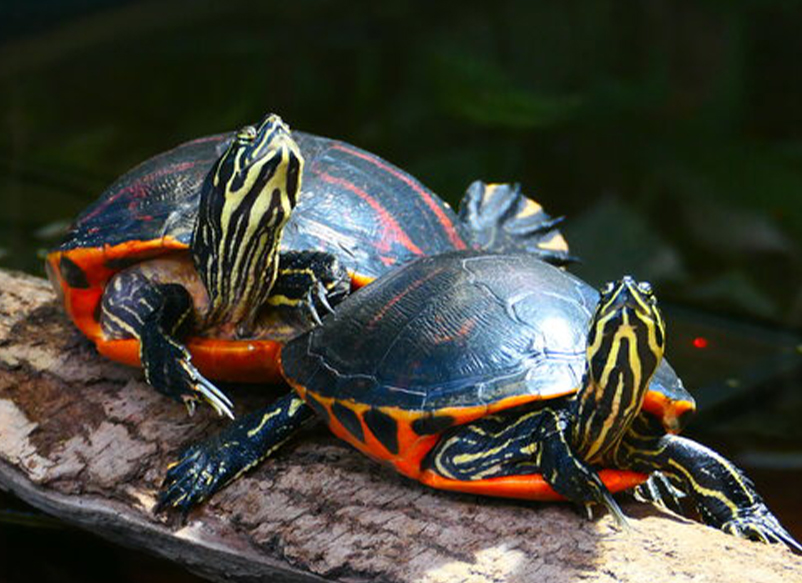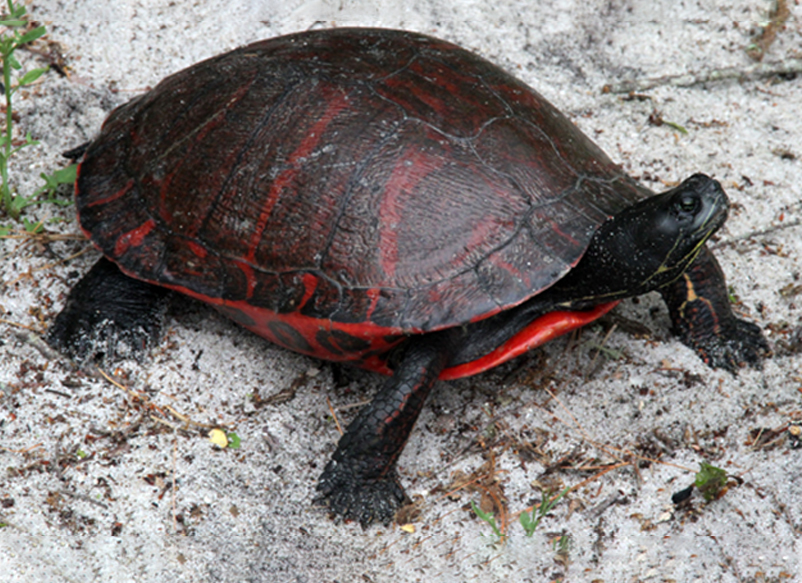| Size | Medium |
| Length | Males around 25 cm, Females up to 35 cm. |
| Type | Semi-aquatic turtle |
| Lifespan | 26 years |
| Food | Pelleted commercial turtle diet, non-toxic aquatic plants, fruits, vegetables |
| Difficulty of Care | Moderate |
| Comparable Breeds | Northern Red-Bellied Turtle, Alabama Red-Bellied Turtle |
The Florida Red Bellied Turtle is a typical freshwater turtle belonging to the state of Florida and parts of southern Georgia. It characterizes itself by beautiful vibrant red markings and idiosyncratic behavior. It is a medium- to large-sized turtle staying in warm, sun-drenched waters, infusing its ecosystems with splashes of color and vitality. In this article, we will scrutinize the Florida Red Bellied Turtle, for example, what it looks like, where it lives, what it eats, what it does, and its conservational status.
Physical Characteristics
One of the most striking characteristics of the Florida Red Bellied Turtle is its plastron side’s bright red or orange color, contrasting with its olive-green-colored carapace. The carapace usually has yellow or reddish patterns that make the turtle unique and eye-catching. Its shell is smooth and slightly domed, making the species easily identifiable among other freshwater turtles.
The Adult Florida Red Bellied Turtles are typically 8-13 inches in shell length, with females rather larger than males; an attribute shared by many turtle species. Males are characterized by having longer and thicker tails and relatively slightly concave plastrons, both useful in mating.

Native Habitat and Distribution
Most of the habitat of Florida red bellied turtles is found in freshwater environments, such as streams, ponds, lakes, streams, and Florida marshes. They prefer biotopes characterized by dense aquatic vegetation and fragmented areas, such as logs or rocks, which they use to warm themselves.
They have even been known to be occasional visitors to brackish waters along the coastline.
The species is quite ubiquitous in the Everglades, an area that is known for biological wealth and aquatic life. However, with their preference for slow-moving or still waters, they are most commonly found in residential ponds and canals in Florida.
Diet and Feeding Habits
The Florida Red Bellied Turtles are half-herbivorous; the majority of their diet, however, is composed mainly of aquatic vegetation, algae, and grasses. They function as part of the ecosystem by breaking up large blooms of water plants. Most adult turtles eat almost only plants, while juveniles will often eat tiny invertebrates, such as insects and snails, to supplement their diet as proteins.
With well-muscled jaws and raking-edged beaks, they are well-adapted to tearing through tough vegetation making them ideally suited for an herbivorous lifestyle, which not only sustains their growth but also the environment in which they dwell by contributing to the health of aquatic habitats at large.
Behavior and Reproduction
Florida Red Bellied Turtles are diurnal, meaning they spend more time during the day. They spend a lot of time basking because basking is an important function for regulating body temperature and supports their vitamin D synthesis process. Basking usually occurs in groups, where multiple turtles can share the same sunning spot.
It reproduces in the spring and early summer when males frantically court females in elaborate displays that involve head bobbing and gentle nudges. Upon selecting a mate, a female will lay her eggs in sandy or loamy soil near water. Interestingly, Florida Red Bellied Turtles are known to use alligator nests for laying their eggs. This might contribute to added protection from predators.
The incubation of the eggs lies between 60 to 90 days. These rely on environmental factors. Hatchlings are produced in late summer or early fall and instinctively swim to the water. Such young turtles are vulnerable prey, but their bright markings and speed provide some camouflage as well as defense against predators.

Florida Red Bellied Turtle Colors
The Florida Red Bellied Turtle is one of the species with bright colors that just set it apart from other turtles in freshwater environments. Its plastron shines with intense red or orange, whereas the olive-green carapace is overlaid with yellowish patterns or reddish markings. Such a great color scheme, together with the smooth shell and striped limbs, gives the turtle its absolutely beautiful appearance reflecting its sunny Florida environment.
Environment
The Florida Red Bellied Turtle is a species found in tropical fresh-warm waters in rivers, lakes, marshes, and ponds, where the aquatic vegetation for food abounds and basking logs or rocks to soak up some sun is at their disposal. They are tolerant of slow-moving, still waters and enter brackish places sometimes-to illustrate their tolerance.
Clean water with stable temperatures can support a healthy environment for these turtles because of their sensitivity to drastic changes in temperature. Diversified aquatic plants with an ecological balance enable them to exhibit their natural behaviors, which include foraging and basking, hence the need to preserve their natural ecosystems to maintain the required ecological balance. In this regard, they control vegetation growth, which points to the significance of conserving these natural ecosystems.

Care Requirements
A Florida Red Bellied Turtle requires a natural habitat as much as possible. The housing of turtle will have to be in a spacious tank or aquarium with freshwater and not too shallow so that it may swim but has some areas for resting. Under heat lamps, it needs to have a basking platform for thermoregulation and vitamin D production. UVB lighting maintains healthy shell and bone development. The temperature in the tank should be between 75°F and 85°F with a basking area of about 90°F.
Aquatic vegetation such as water lettuce or duckweed should comprise the diet of the turtle with commercial turtle pellets used only for supplementation. You sometimes may feed protein sources such as insects and fish to juveniles. Maintenance of the tank is vital, with regular changes in the water coupled with filtration to reduce bacteria multiplication and hygiene results. Proper care of these turtles ensures that they can be kept and thrive in captivity, which will bring years of pleasure to their keepers.
Role in Ecosystem
The Florida Red Bellied Turtles are an integral component in the ecosystems of Florida waters. The grazing on aquatic vegetation performed by this species prevents overgrowth conditions, which would otherwise cause depletion of oxygen in the water. This would therefore cause harm to other aquatic species. Their eggs and hatchlings also become a food source for many predators, such as birds, raccoons, and even fish, and therefore play a critical role as a link in the food chain.
Their basking sites, which are most often shared by various turtle species, create diversity in habitats and interactions in the moss, algae, and insects, for example. In return, these turtles depend on the health of their ecosystems to live, demonstrating how life’s interconnectedness manifests.
Conservation Status and Threats
Fortunately, the Florida Red Bellied Turtle is currently listed as a species of least concern on the International Union for Conservation of Nature (IUCN) Red List. This does not, however, mean the species is free from threat. Habitat loss, particularly because of urbanization, pollution, and climate change, stands out as a major challenge to their survival.
The illegal pet trade has also reduced some local populations. Although colorful, their aesthetic appeal makes them a very attractive fascination among reptile enthusiasts. Through this illegal means of removal, they disturb natural ecosystems and jeopardize their populations.
Habitat preservation, public education, and reinforcement of stricter enforcement of wildlife protection laws are also done to protect the Florida Red Bellied Turtle. Other conservation advocacy includes responsible pet ownership and not letting captive turtles roam the wild as it may introduce diseases to the native population.
How to Spot Florida Red Bellied Turtles
For nature lovers and wildlife photographers, seeing the Florida Red Bellied Turtle in its natural habitat is a rewarding experience. They are found basking on logs or rocks, especially during warmer months. They are often found with other turtle species, like cooters and sliders.
Quiet and respectful distance ensures minimal disturbance to their natural behavior. Observing these red bellied turtle Florida turtles in their element provides a glimpse into the rich biodiversity of Florida’s aquatic environments.

Why Florida Red Bellied Turtles Matter
Apart from their ecological value, Florida Red Bellied Turtles have great cultural and educational value. They, therefore, represent freshwater conservation and prompt the importance of maintaining habitats that make up the aquatic ecosystems. Their presence in Florida’s waters symbolizes the natural beauty and biodiversity of the state, which should be protected for generations to come.
Conclusion
The Florida Red Bellied Turtle is an incredible species that amalgamates the attraction and life of freshwater habitats of Florida. From their bright red markings to their crucial role in sustaining ecosystem balance, the Florida Red Belly Turtles present a treasure within the Sunshine State. Although it is not currently endangered, the need for conservation cannot be avoided.
We can conserve Florida Red Belly Turtles and their habitats by keeping protected areas safe as well as continuing to raise community awareness. Whether a wildlife enthusiast or simply an avid observer, note next time you see one of the gorgeous red bellied turtle florida stretching out in the sun how beautiful and important that sight can be to the natural world.
Related: Eastern Box Turtle

